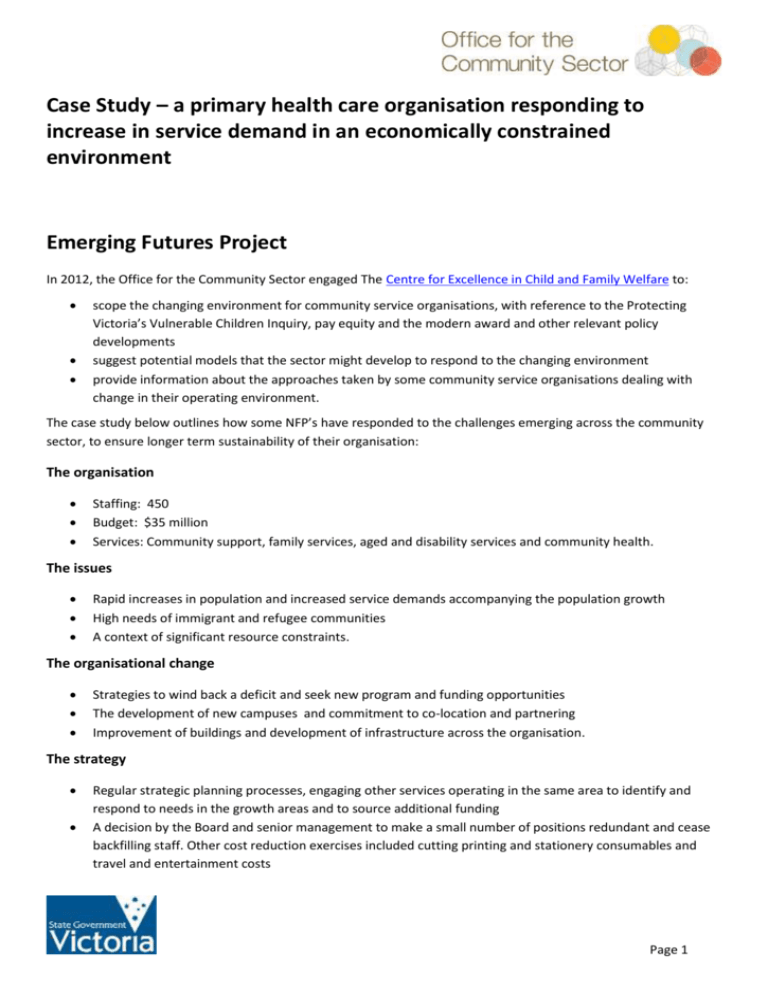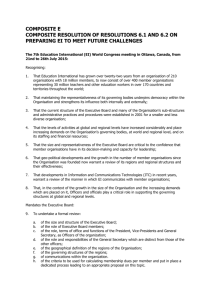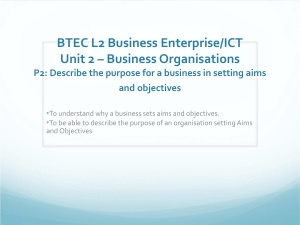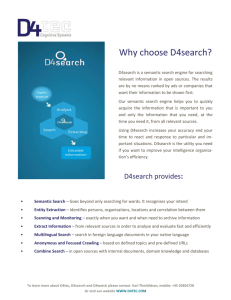Emerging Futures Project In 2012, the Office for the Community
advertisement

Case Study – a primary health care organisation responding to increase in service demand in an economically constrained environment Emerging Futures Project In 2012, the Office for the Community Sector engaged The Centre for Excellence in Child and Family Welfare to: scope the changing environment for community service organisations, with reference to the Protecting Victoria’s Vulnerable Children Inquiry, pay equity and the modern award and other relevant policy developments suggest potential models that the sector might develop to respond to the changing environment provide information about the approaches taken by some community service organisations dealing with change in their operating environment. The case study below outlines how some NFP’s have responded to the challenges emerging across the community sector, to ensure longer term sustainability of their organisation: The organisation Staffing: 450 Budget: $35 million Services: Community support, family services, aged and disability services and community health. The issues Rapid increases in population and increased service demands accompanying the population growth High needs of immigrant and refugee communities A context of significant resource constraints. The organisational change Strategies to wind back a deficit and seek new program and funding opportunities The development of new campuses and commitment to co-location and partnering Improvement of buildings and development of infrastructure across the organisation. The strategy Regular strategic planning processes, engaging other services operating in the same area to identify and respond to needs in the growth areas and to source additional funding A decision by the Board and senior management to make a small number of positions redundant and cease backfilling staff. Other cost reduction exercises included cutting printing and stationery consumables and travel and entertainment costs Page 1 A project approach, seconding the CEO to oversee the process while a Program Director stepped into the Acting CEO role for 12 months Sourcing other revenue to support existing service delivery and using capital funding to expand and update existing campuses and to develop new campuses and initiatives. One new campus co-located services relating to child and family services across primary and secondary services. Another new initiative was the development of a GP super clinic with Federal funding to provide a combination of private and public services Implementation of innovative program responses: for example, providing group work rather than individual interventions to increase the number of clients seen, reducing translation costs by using video conference translation and group translation, texting clients to reduce the number of missed appointments Changing service responses at the micro level to address specific community needs: for example, within the Maternal and Child Health service priority given to mothers with very young infants, a specific Vitamin D clinic established for refugees Communication strategies to inform service users of changes and any delays to service The outcome The deficit was funded and a program of improving site infrastructure and numbers of service sites were implemented, enabling: o co-location with other services o partnerships with for-profit providers o services to be provided in local areas previously without services o specific needs of specific communities to be addressed o services at the one site across primary prevention and secondary intervention, thereby allowing referral, collaborative practice and mutual learning. Policy and program implications Financial governance is critical to enabling flexibility for community service organisations – for example, simultaneously addressing an operational deficit resulting from changes in government funding while drawing on reserves for capital investment allows the enhancement of services and development of new services Co-location can facilitate service provision across the service continuum where the services are auspiced by different organisations Significant investment by government in growth areas is necessary to strengthen program provision across the service continuum Service planning and responsiveness requires good research and timely information about population movements and the specific needs of communities The strengths and interests of staff across the organisation are essential to facilitating new opportunities. Page 2 Published by Office for the Community Sector Department of Planning and Community Development 1 Spring Street Melbourne Victoria 3000 Telephone 03 9208 3543 April 2013 Copyright State Government of Victoria 2011. This publication is copyright. No part of it may be reproduced by any process except in accordance with provisions of the Copyright Act 1968. Authorised by the Victorian Government, Melbourne. Accessibility If you would like to receive this publication in an accessible format, such as large print or audio, please contact the Office for the Community Sector on 03 9208 3543, or email communitysector@dpcd.vic.gov.au This publication is also available at: http://www.dpcd.vic.gov.au/communitydevelopment/communitysector/resources-for-nfps/strategic-business-planning Page 3











